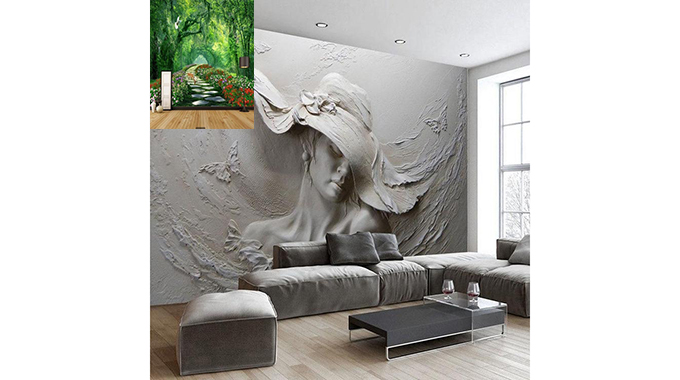The Herald

Talent Gore Lifestyle Writer
Whether you want to put your own stamp on a new place or you’re just putting on a fresh lick of paint on the one you already have, redecorating can be an exciting change.
3D wall paper has taken over paint in the interior décor, the trend is now taking over homes, offices, salons and night clubs.
But it can also be a big investment when it comes to time and money, with the challenge of finding something that will work in your home and that you’re not going to end up hating in a few years’ time. So is there anything that could make the process a bit easier?
After pervading the home decor trends-sphere in the ’70s, ’80s and ’90s, wallpaper became the stuff of our parents and grandparents’ decor.
It wasn’t cool, it wasn’t contemporary, it wasn’t chic by all definitions, it was stale, but in 2018, something changed. Wallpaper experienced a revival, with tropical wallpaper covering some of the most stylish interiors in homes.
Bold 3D wallpaper has officially joined the ranks of other 2019 wallpaper trends, with people searching for “bold print wallpaper” and redesigning their homes more frequently than they have in years past.
Not only is bold 3D wallpaper a 2019 home decor trend, but it’s also available in high and diverse supply, bold wallpaper has all the elements of a trend that promises to take over.
Real or illusory 3D surfaces are great for adding texture and drama into the home.
Interior designer, Dennis Katende, said 3D wallpaper’s roots are in France where it was done on stone, however, wall paper has been modernised from stones to walls of homes.
“With the many distinguishing characteristics as compared to paint, wall paper is very durable and can resist all weather conditions,” he said.
“It also has varieties such as 3D effects and illusions, geometrical shapes, fox bricks and plain wallpaper which bring a good sense of decoration in a home than paint would have done.”
Bold wallpaper encompasses tropical wallpaper and a handful of other iconic prints.
Katende said that technology is going to be used more in the future in terms of coming up with ideas, creating designs, and finding new ways to enhance our spaces.
“If you’re spending money on your home and it’s something that you live in every day, you’re going to want to do it right. Technology can help with that,” he added.
Tech has become a big part of the job for professional interior designers, with software and computer-aided design tools making it easier to visualise rooms, experiment with ideas and communicate plans with clients.
“These software packages now give a better idea of the space and allow you to be a lot more involved with the design,”Katende said.
“I think one of the fundamental things is people haven’t got a grasp on the volumetric of their space, so when they go to buy a sofa or a cabinet, they’re measuring but they might not take into account the ceiling height, or what other elements are in the room might make it look smaller.”
“The 3D wallpaper must be put up by someone experienced in interior designing, home staging and fabric decoration.”
Having a professional computer-generated design may make it easier to plan what to do with your home, but if you don’t have a budget for an interior designer, there are still plenty of tools you can use to create your own design and overcome any spatial issues.
While 3D renderings may give a good idea of what your newly-decorated home be like, in the future we may have something a bit more interactive than just looking at a design on a screen.
With virtual reality, designers and homeowners could walk around a room and get an even better sense of the space, like in the recent BBC design programme, “Your Home Made Perfect”. In the show, homeowners could explore two different designs using VR headsets, and decide which one would work better for them, before building it in reality.
“Take that one step further into virtual reality and you’ll be able to position yourself in the room and experiment with things,” Katende said.
“In the future people you’ll be able to choose different colours, tables, chairs, lighting, explore the space a lot more and try new things in VR.”
While virtual reality decorating might still sound a bit sci-fi for most of us, augmented reality is slowly becoming a more accessible tool, with new apps that can help you visualise whether the red couch that looks great in the shop will look just as good in your house.
“That’s where we’re really going to go with technology and interiors. And with augmented reality we’ll get much more creative,” Katende adds.
“It will allow people to look at the full spectrum of colours, look at different soft furnishings, lighting. We can position furniture, we can play around with ideas, and I think we’ll end up with more unique styles in people’s homes.”
Smart homes are becoming a more common concept, with the likes of Google Home and Amazon Alexa enabling voice commands for different tasks around the house, along with other systems that will easily control temperature or lighting. But smart tech could also spread into other aspects of our homes in the not-too-distant future.
“We’re going to see smart technology incorporated into interiors too. It will be about adaptability and allowing people to have something that can change in their home,” Katende said.
When it comes to high-tech furniture, this could include TVs that retract into the ceiling or blend into the wall when they’re not in use, or robotic adaptable furniture that can be controlled remotely, like that which Ikea is developing for people who live in small spaces. The colours on your walls could also potentially be changed whenever you like.
“Larger commercial projects are already using wallpaper LED panels that are beautiful,” he said.
“So in the future you could have images, colour or static graphics. You can be sitting in a room with a beach or mountain surround, or just have something that looks like traditional wallpaper or a plain colour.”
Katende added: “Technology is becoming more linked, with our phones and wearable technology analysing everything from our mood to blood pressure. So technology could adapt your space to suit your mood or state, the time of day or the time of year.”
“You could say that when you walk into a room the colours on the walls will change. Like creating spaces that will help energise you to wake up in the morning, or spaces that will calm you down and send you to sleep at night.”
New technologies are showing plenty of opportunities for the future of home design. While redecorating your kitchen in the next 10 or 20 years might still involve comparing different types of cabinets and tiles, there may also be some augmented reality, virtual reality, and new high-tech gadgets that will make the process a bit more interesting or intuitive.”





































